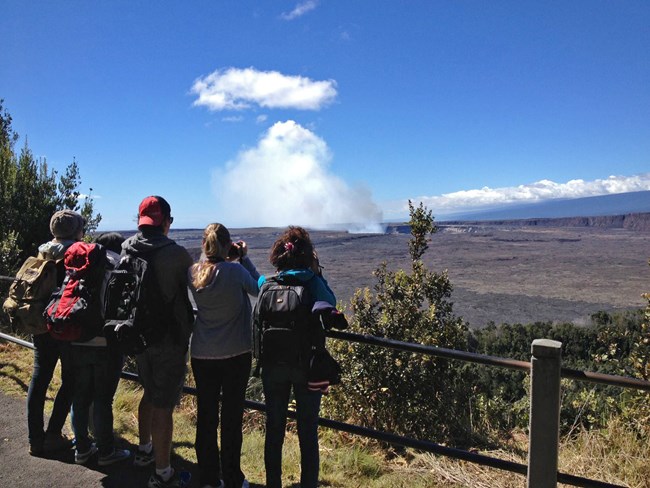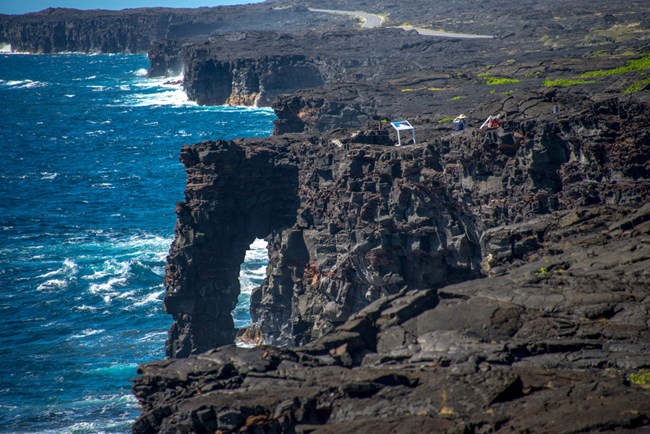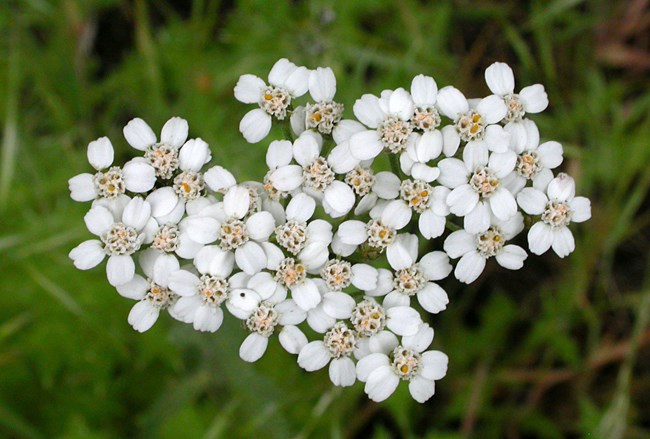Part of a series of articles titled Park Air Profiles.
Article
Park Air Profiles - Hawai'i Volcanoes National Park
Air Quality at Hawai'i Volcanoes National Park

Most visitors expect clean air and clear views in parks. Hawai'i Volcanoes National Park (NP) usually enjoys great air quality relative to other parks. However, the Kilauea Volcano and other volcanic features at the park emit noxious gases that can pose serious human and ecosystem health concerns.
Kilauea's nearly continuous eruption emits sulfur dioxide (SO2) gas and results in volcanic air pollution downwind of the volcano. The SO2 in eruption plumes reacts with oxygen, water, and particles in the air to form sulfuric acid droplets and solid sulfate particles known as vog (volcanic smog) and corrosive acid rain. Vog damages crops and can aggravate pre-existing respiratory ailments (Orr et al. 2013). Vog also creates a haze that obscures visibility. Adding to the haze are marine aerosols, which can make it even harder to see far and clearly. In addition, the volcano emits hydrogen sulfide, hydrogen chloride, hydrogen fluoride, mercury, and other harmful gases. When hot lava reaches sea water, large clouds of mist, called laze (lava haze) can form. Laze contains hydrochloric acid and other airborne contaminants that are harmful to human health.
Some human-caused air pollution sources can also degrade park air quality, including urban and industrial areas on the islands of Oahu and Maui. These airborne pollutants can harm the park's natural and scenic resources such as soils, surface waters, vegetation, and visibility. The National Park Service works to monitor air quality and address air pollution effects at Hawai’i Volcanoes NP, and in parks across the U.S., through science, policy and planning, and by doing our part.
Sulfur and Nitrogen
Short term exposure to high levels of sulfur dioxide (SO2) and particulate matter (PM2.5) can be harmful to human health at Hawai'i Volcanoes NP. These conditions occur naturally as a result of ongoing volcanic activity. Volcanic activity and certain weather conditions can create high concentrations of SO2 at Kilauea's summit, impacting the popular Kilauea Visitor Center and Jaggar Museum. This happens most frequently during the winter months when tradewinds are absent. In response, U.S. Geological Survey (USGS) scientists with the Hawaiian Volcano Observatory and NPS scientists monitor air quality in numerous locations around the park and share real-time data with park staff and the public. Advisories are issued and the park may even close appropriate areas when hazardous conditions exist. Visit the current conditions website to find out about current SO2 and PM2.5 conditions and the health advisory level for the park.
In addition to human health concerns, sulfur and nitrogen compounds deposited from the air may have harmful effects, including acidification, on soils, lakes, ponds, and streams. Excess nitrogen can lead to nutrient enrichment, a process that changes nutrient cycling and alters plant communities. Healthy ecosystems can naturally buffer a certain amount of pollution, but as nitrogen and sulfur accumulate, a threshold is passed where the ecosystem is harmed. “Critical load” is a term used to describe the amount of pollution above which harmful changes in sensitive ecosystems occur (Porter 2005). Nitrogen deposition exceeds the critical load for one or more park ecosystems (NPS ARD 2018). Ecosystem sensitivity to nutrient enrichment at Hawai'i Volcanoes NP relative to other national parks is high (Sullivan et al. 2011a; Sullivan et al. 2011b). Lowland grasslands and meadow communities at the park may be particularly vulnerable to changes caused by nitrogen deposition. Invasive grasses tend to thrive in areas with high nitrogen deposition, displacing native vegetation adapted to low nitrogen conditions (e.g., Brooks 2003, Schwinning et al. 2005). Non-native plants and wildlife introduced by humans severely threaten native plants and animals at the park.
Sulfur and nitrogen can also acidify surface waters and soils. This can have deadly effects on sensitive species and inhibit natural processes. Ecosystem sensitivity to acidification from sulfur and nitrogen at Hawai’i Volcanoes NP relative to other national parks is high (Sullivan et al. 2011c; Sullivan et al. 2011d). Some plants are sensitive to acidification, search for acid-sensitive plant species found at Hawai'i Volcanoes NP. Park streams and ponds may be particularly affected by sulfur compounds emitted from the Kilauea Volcano.
Visit the Hawai’i Volcanoes NP current conditions website to find out about current conditions and the health advisory level. Also, check out the NPS air quality conditions and trends website for park-specific nitrogen and sulfur deposition information. Hawai’i Volcanoes National Park has been monitoring sulfur dioxide since 1986. Explore air monitoring »
Persistent Pollutants
Pollutants like mercury and pesticides are concerning because they are persistent and toxic in the environment. These contaminants can travel in the air thousands of miles away from the source of pollution, even depositing in protected places like national parks. In addition, while some of these harmful pollutants may be banned from use, historically contaminated sites continue to endure negative environmental consequences.
When deposited, airborne mercury and other toxic air contaminants are known to harm wildlife like birds and fish, and cause human health concerns. Many of these substances enter the food chain and accumulate in the tissue of organisms causing reduced reproductive success, impaired growth and development, and decreased survival.
Dragonfly larvae sampled from two sites at Hawai’i Volcanoes NP had mercury concentrations at sub-impairment or low impairment levels, suggesting fish from these sites would not exceed the US EPA benchmark for protection of human health (Eagles-Smith et al. 2020; Eagles-Smith et al. 2018). However, the data may not reflect the risk at other unsampled locations in the park.
The NPS Air Resources Division reports on park conditions and trends for mercury. Visit the webpage to learn more. Fish consumption advisories may be in effect for mercury and other contaminants (NPS 2022).
Visibility

Park vistas of volcanic formations are sometimes obscured by haze, reducing how well and how far people can see. Visibility reducing haze is caused by tiny particles in the air, and these particles can also affect human health. Many of the same pollutants that ultimately fall out as nitrogen and sulfur deposition contribute to this haze. Organic compounds, soot, and dust reduce visibility as well.
The air is generally very clean in the park, so even a very small amount of particle pollution can cause a noticeable haze. Park visibility conditions have been documented with no significant trends since 2000. Although much of the visibility reducing haze in the park is natural, the park has not reached the Clean Air Act goal of no human caused impairment.
.
Visibility effects:
- Reduction of the average natural visual range from about 155 miles (without pollution) to about 105 miles because of pollution at the park
- Reduction of the visual range to below 40 miles on high pollution days
Visit the NPS air quality conditions and trends website for park-specific visibility information. Hawai’i Volcanoes NP has been monitoring visibility since 2000. Check out the live air quality webcam of the Halema´uma´u Crater, current sulfur dioxide and fine particulate conditions, and explore air monitoring »
Ground-Level Ozone

At ground level, ozone is harmful to human health and the environment. Ground-level ozone does not come directly from smokestacks or vehicles, but instead is formed when other pollutants, mainly nitrogen oxides and volatile organic compounds, react in the presence of sunlight.
Over the course of a growing season, ozone can damage plant tissues making it harder for plants to produce and store food. Elevated ozone levels reduce photosynthesis and growth in tropical trees, and increase tree water use (Cheesman et al. 2024, Jamal et al. 2024). Tree uptake of ozone impairs carbon storage in vegetation and soil of tropical forests (Cheesman et al. 2024). A few ozone-sensitive plant species occur in the park but those non-native species are uncommon (Kohut 2004). Past monitoring found relatively low levels of ozone in the park that would be unlikely to cause ozone injury to plants. Search for ozone-sensitive plant species found at Hawai'i Volcanoes NP.
Explore Other Park Air Profiles
There are 47 other Park Air Profiles covering parks across the United States and its territories.
References
Brooks, M. L. 2003. Effects of increased soil nitrogen on the dominance of alien annual plants in the Mojave Desert. Journal of Applied Ecology. 40:344–353.
Cheesman AW, Brown F, Artaxo P, Farha MN, Folberth GA, Hayes FJ, Heinrich VHA, Hill TC, Mercado LM, Oliver RJ, O’Sullivan M. Uddling J, Cernusak LA, Sitch S. 2024 Reduced productivity and carbon drawdown of tropical forests from ground-level ozone exposure. Nature Geoscience. https://doi.o
Eagles-Smith, C.A., J.J. Willacker, S.J. Nelson, C.M. Flanagan Pritz, D.P. Krabbenhoft, C.Y. Chen, J.T. Ackerman, E.H. Campbell Grant, and D.S. Pilliod. 2020. Dragonflies as biosentinels of mercury availability in aquatic food webs of national parks throughout the United States. Environmental Science and Technology 54(14):8779-8790. https://doi.org/10.1021/acs.est.0c01255
Eagles-Smith, C.A., S.J. Nelson., C.M. Flanagan Pritz, J.J. Willacker Jr., and A. Klemmer. 2018. Total Mercury Concentrations in Dragonfly Larvae from U.S. National Parks (ver. 6.0, June 2021): U.S. Geological Survey data release. https://doi.org/10.5066/P9TK6NPT
Jamal R, Narayan S, Dubey R, Kannaujia R, Rai R, Behera SK, Shirke PA, Pandey V, Barik SK. 2023. Response of tropical trees to elevated ozone: a Free Air Ozone Enrichment study. Environmental Monitoring and Assessment 195:238. https://doi.org/10.1007/s10661-022-10713-5
Kohut, B. 2004. Assessing the Risk of Foliar Injury from Ozone on Vegetation in Parks in the Pacific Island Network. Available at https://irma.nps.gov/DataStore/Reference/Profile/2181540
Kohut R.J. 2007. Ozone Risk Assessment for Vital Signs Monitoring Networks, Appalachian National Scenic Trail, and Natchez Trace National Scenic Trail. NPS/NRPC/ARD/NRTR—2007/001. National Park Service. Fort Collins, Colorado. Available at https://www.nps.gov/articles/ozone-risk-assessment.htm
[NPS] National Park Service. 2022. Fish Consumption Advisories. https://www.nps.gov/subjects/fishing/fish-consumption-advisories.htm
[NPS] National Park Service. 2001. Sulfur dioxide advisory system installed at Hawaii Volcanoes. In J. Selleck, M. Rees, and E. Rockwell (Eds.). Natural Resource Year in Review – 2000. Denver, CO. p. 15. Available at https://irma.nps.gov/DataStore/Reference/Profile/645077
Orr, T. R., C. Heliker, M. R. Patrick. 2013. The Ongoing Pu‘u ‘ Ö ö Eruption of Kilauea Volcano, Hawai‘i—30 Years of Eruptive Activity. U.S. Geological Survey Fact Sheet 2012–3127. Available at http://pubs.usgs.gov/fs/2012/3127/
Schwinning, S., B. I. Starr, N. J. Wojcik, M. E. Miller, J. E. Ehleringer, R. L. Sanford. 2005. Effects of nitrogen deposition on an arid grassland in the Colorado plateau cold desert. Rangeland Ecology and Management. 58: 565–574.
Sullivan, T. J., McDonnell, T. C., McPherson, G. T., Mackey, S. D., Moore, D. 2011a. Evaluation of the sensitivity of inventory and monitoring national parks to nutrient enrichment effects from atmospheric nitrogen deposition: main report. Natural Resource Report NPS/NRPC/ARD/NRR—2011/313. National Park Service, Denver, Colorado. Available at https://www.nps.gov/articles/nitrogen-risk-assessment.htm
Sullivan, T. J., T. C. McDonnell, G. T. McPherson, S. D. Mackey, and D. Moore. 2011b. Evaluation of the sensitivity of inventory and monitoring national parks to nutrient enrichment effects from atmospheric nitrogen deposition: Pacific Island Network (PACN). Natural Resource Report NPS/NRPC/ARD/NRR—2011/323. National Park Service, Denver, Colorado. Available at https://irma.nps.gov/DataStore/Reference/Profile/2168727
Sullivan, T. J., McPherson, G. T., McDonnell, T. C., Mackey, S. D., Moore, D. 2011c. Evaluation of the sensitivity of inventory and monitoring national parks to acidification effects from atmospheric sulfur and nitrogen deposition: main report. Natural Resource Report NPS/NRPC/ARD/NRR—2011/349. National Park Service, Denver, Colorado. Available at https://www.nps.gov/articles/acidification-risk-assessment.htm
Sullivan, T. J., McPherson, G. T., McDonnell, T. C., Mackey, S. D., Moore, D. 2011d. Evaluation of the sensitivity of inventory and monitoring national parks to acidification effects from atmospheric sulfur and nitrogen deposition: Pacific Island Network (PACN). Natural Resource Report NPS/NRPC/ARD/NRR—2011/370. National Park Service, Denver, Colorado. Available at https://irma.nps.gov/DataStore/Reference/Profile/2170598
Sullivan T.J. 2016. Air quality related values (AQRVs) in national parks: Effects from ozone; visibility reducing particles; and atmospheric deposition of acids, nutrients and toxics. Natural Resource Report. NPS/NRSS/ARD/NRR—2016/1196. National Park Service. Fort Collins, Colorado. Available at https://www.nps.gov/articles/aqrv-assessment.htm
Last updated: September 30, 2024
